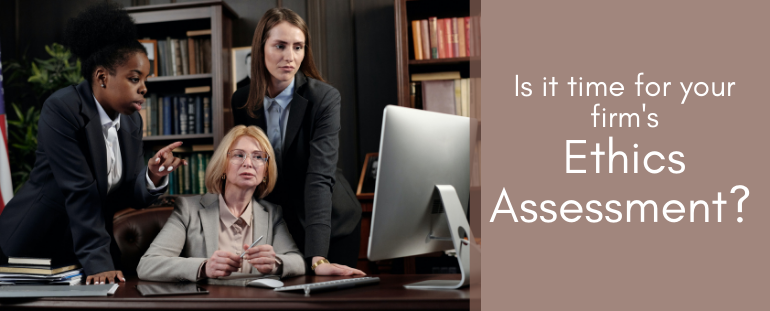
By David Majchrzak
On its website, one safety inspection provider lists several reasons for employers to use its services. Such inspections explore whether safety and health policies and procedures are being followed; identify and correct safety and health hazards before they cause injuries or illnesses; determine the need for safety training; and show employees that the business is concerned about their safety and health.
These same reasons, translated to the professional responsibility context, similarly apply to why law firms should conduct ethics assessments on a regular basis: they identify opportunities to improve policies, assess compliance with existing policies, and demonstrate to all at the firm that ethical responsibilities are taken seriously. And, because Rule of Professional Conduct 5.1 requires lawyers with managerial authority to “make reasonable efforts to ensure that the firm has in effect measures giving reasonable assurance that all lawyers in the firm conform to the Rules of Professional Conduct,” it could help satisfy a duty.
When conducting law firm assessments — a fellow professional responsibility lawyer suggested that I cease calling them audits because of the anxiety the word causes — I have found that an easy way to locate potential areas of concern is to first look at what conduct the firm rewards. Even very positive conduct has potential negative repercussions. For example, firms that place a heavy emphasis on billing requirements encourage their lawyers to improve their craft by maintaining a regular, heavy involvement in the practice. But, such policies can also contribute to lawyers who struggle to reach the minimum opting to pad their bills. Or, on a less obvious front, they could inadvertently yield inefficiency — or worse yet, errors — from lawyers who work too many hours without taking the breaks needed to work at an optimal level.
I also like to look at what firms feel are their strengths. Often those are the areas that are unchecked because they have traditionally performed well. Plus, over time, as Professor Dorothy Leonard noted, core competencies can evolve into “core rigidities,” sometimes standing in the way of progress. In that way, past successes can impede change and adoption of new modalities that may be more efficient, more profitable, or simply necessary, such as to comply with changes in the Rules of Professional Conduct or the State Bar Act.
On the flip side, I ask what are a firm’s weaknesses. Perhaps more intuitively, the responses to this question usually also key in on areas of need. But it is largely because they are neglected or at least marginalized as being “less important.” For example, lawyers who are less organized may acknowledge that fact, but embrace their approach as some form of controlled chaos. But the same lawyers are at a higher risk for having issues with diligence or missing deadlines.
Another important step is examining how a law firm is operating to satisfy obligations. This entails a review of both policies and execution. For example, to protect confidentiality, a firm may have a policy holding that work on clients’ matters may only be performed on firm equipment, which is set up to work only when it is behind a firewall or while attached to a virtual private network. But, in practice, some individuals may be electing to take work home on a flash drive — rather than taking the firm laptop — and working on the matter on a shared personal computer, imperiling confidentiality.
Finally, the way that firms take in clients may impact a lot of the risk they bear. Everybody knows to do a conflict check before accepting an engagement. But from firm to firm, there are wild differences in what happens next.
Many policies and procedures are well-aligned with the goal of determining whether the lawyer and client are good fits for one another. These might include having a client vetting committee or some matrix or other tool to assess whether the client and firm are good matches. Telling signs that a new process should be considered include withdrawals from or substitutions out of multiple cases, significant accounts receivable, and recurrent feelings that the firm has “difficult clients.”
Of course, there are many facets of a firm’s operations that can be examined to improve risk management. These can include, among other things, accounting, billing, calendaring, client screening and relationships, conflict management, records management, and staff management and training. It is often far too easy for lawyers to focus exclusively on client matters and lose sight of managing the law firm’s operations. But that is a critical aspect, and one that should be regularly monitored and assessed.
David Majchrzak is Deputy General Counsel and a Shareholder at Klinedinst PC.